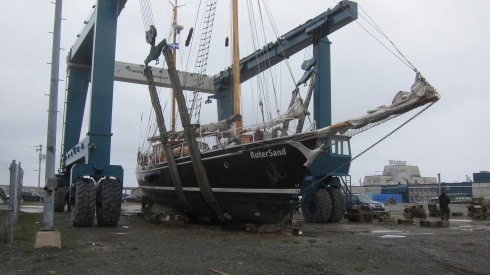As seen recently on a 24 foot sailboat, these engine mounts have softened up to the point where the engine oil pan is now touching and eating away at the transverse engine supports. Something to check for as you put away you boat for the winter! 

This 300 Ton travel lift made short work of hauling and launching the Roter Sand. Expert and efficient service at Riviere au Renard, Gaspe
I often see situation on either exhaust hose or stuffing boxes where there is not enough space on the hose to double clamp. Most small vessels use ordinary screw type hose clamps and if the screw loosens or strips there can be a serious risk of water getting in.
T-bolt type hose clamps are much more resistant and are a reasonable solution when only one hose clamp can be set.
As seen on a three year old sport cruiser this past week, these Bravo three outdrives have corroded in a significant fashion while being immersed in fresh water. This is not a normal amount of corrosion particularly since the drives are well protected by anodes.
This is more likely a result of boats being connected together through the marina shore power grounding wire which allows current to flow between them more easily.
The solution for this is a Galvanic Isolator on the ground wire just inboard of the shore power dual pole breaker. Easy to wire up and will save you a lot of money down the line. The isolator blocks low amperage current associated with galvanic corrosion but will open up the conductor ( close the circuit) if there is short to ground.
Learn more at http://www.sterling-power.com/products-galvanic-why.htm
Interesting case a little while ago of a late 70’s 34 foot cruiser which was up on stands for a season or two. The hull was supported at three points: The aft corners on the chines and forward just aft of the stem. As can be seen in the photo, the surface of the block supporting the front was too small and eventually the blocks passed right through the hull.
I think there are a couple of interesting things here. 1- The yard assumed that the structure was designed to handle a point load as is the case on most modern cruisers, but this vessel only has the hull shell to support the load. No keel or back bone and no local reinforcement. 2- The hull is made with a balsa core which delaminated long ago. So the already weakened structure did not stand a chance.
Although there are two 6×6 timbers below the keel, there was in fact only one at the time of the collapse. Note to owners of older cruisers: make sure the hull is supported on a sufficient number of blocks so the pressure on the shell is minimized.

Insulating over the polyurethane with Roxul 1 inch insulating material. The idea here is to create a barrier between a flame and the polyurethane.
I often see this problem on smaller older sailboats. A drain for a sink or cockpit drains that go to a below the waterline thru hull fitting. Even though this installation was very solid it is still not safe without a seacock. To conform to ABYC H-27 or Transport Canada TP 1332 section 3.3.1 below the waterline thru hull fittings shall have a seacock in order to shut off underwater penetrations. A ball valve is the best type of seacock for this application. Apart from saving you from sinking in the event the hose comes loose it will also allow you to do maintenance on piping etc. without having to haul your boat.
This is pretty common. A piece of equipment is relocated or added and the DC wiring is short. So the temporary measure to connect the wires is forgotten about and becomes permanent. In this case it is positive cable from the battery charger and so is potentially carrying 50 amps. Note the stainless bolt making the connection.
Never a good sign when you come across amateur fiberglass work around the keel of a sailboat. In this case the keel boats have been glassed over which was probably effective in stopping the leak! At least for now. Of course there is no way for an owner or a surveyor to judge the condition of the bolts anymore and the bolts themselves are now soaked in water year round slowly corroding as the water is depleted of oxygen…
Leaks through the hull to keel joint should be repaired by resealing or caulking the joint, from the outside.